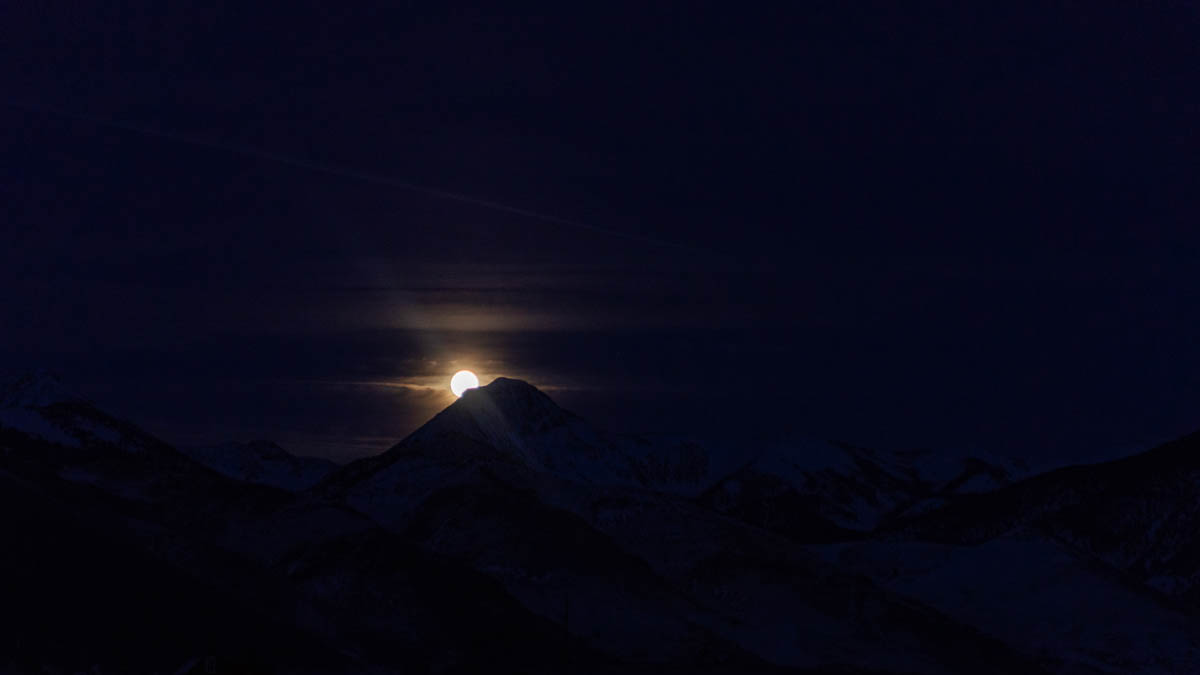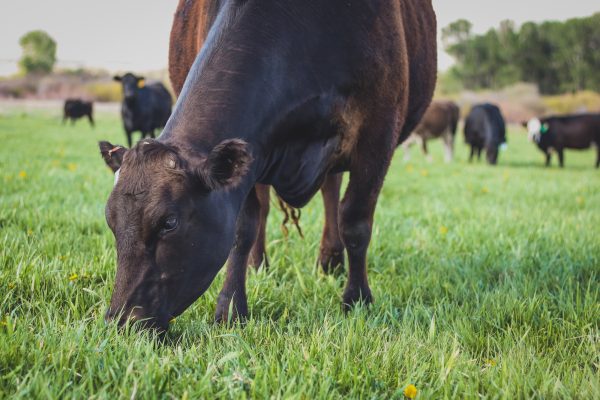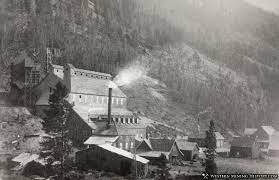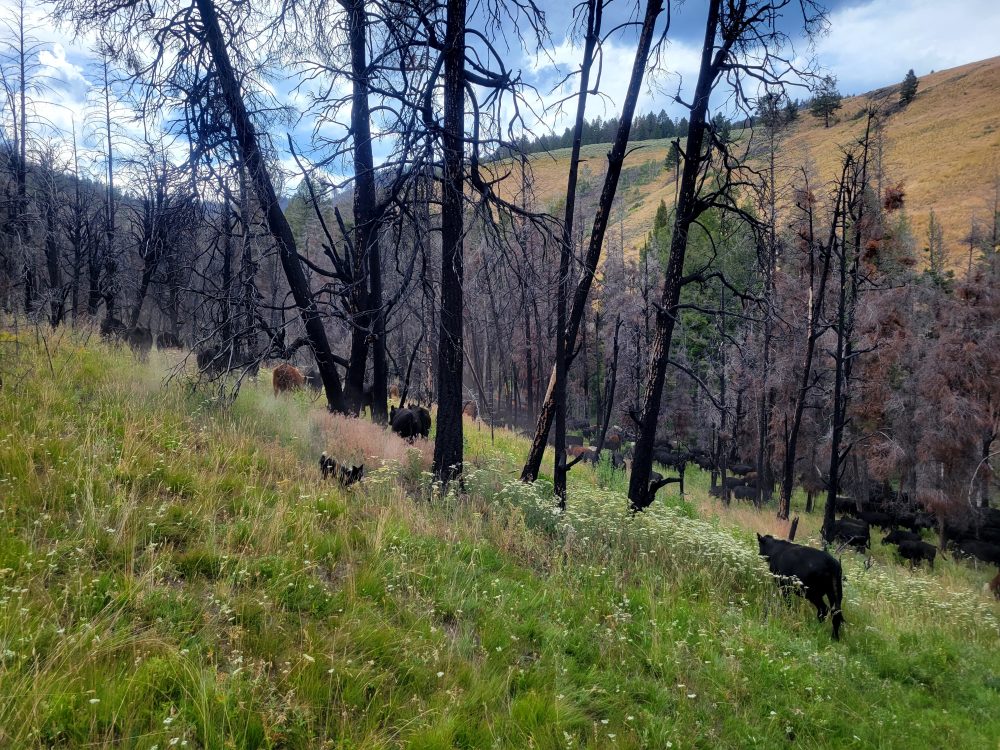When Tom takes off the winter blankets from the hives, I try to remember to keep my mouth shut. I’m no beekeeper, to be sure, but you pick up a few things when you have as many bees as we do on the Ranch: over 1 million, by Tom’s estimate.
Since our headquarters ranch is about 2.5 miles long, the easiest way to get from point ‘A’ to point ‘B’ to check on cattle or fix fence is the lowly dirt bike. It’s a necessary tool in our rough-roaded and rocky mountain valley. I like the dirt bike. I’m clicking along at 35 mph, whistling a happy tune, maybe even singing. I swing the handlebars over in anticipation of a nice wide curve at the top of the ranch, and put the lean into it. I’m out there in the wind, and I can feel my mustache wiggling in the breeze (sorry girls). And that’s when they hit me.
Like big raindrops from a thunderhead, thick splats will hit me on the face. Apis mellifera. The honeybee. Those white wooden (yep, they still make them out of wood!) hives are teeming with a cloud of spring workers, eager for the nectar at hand. The harvest is ripe, after all. Fields, fencerows and even the dry rangeland is abloom with the color of wildflowers on a spring day. I wish you could see it.
And I usually remember the bees as I drive along, but sometimes, in song (or just open mouthed) with the beauty all around- the snow in the peaks, radiant green of the grass, and the glossy shine of Black Angus coat- I’ll forget to keep my mouth shut.
Worker bees. There can be a swarming fog of them coming off Tom’s hives and I have occasionally had one get in my stupidly open mouth as I cruise along on my bike, but I have thankfully so far been able to spit them out before they sting my tongue. Honeybees have been a fixture on Alderspring since the beginning, nearly a quarter century ago. We had beehives on the Tendoy Ranch where we started out, and on the Pahsimeroi Ranch since we arrived here almost 13 years ago.
Beekeepers have long set up clusters of hives scattered across the broad Pahsimeroi. You can see them as you drive up the main valley road: like miniature apartment complexes, the telltale huddled stacks of white boxes stand every few miles along the edges of fields and hay meadows. The bees harvest nectar from flowers. Sweet clover, white clover, alfalfa and red clover, plants classified as legumes, dominate their preferred fields of choice. We offer sainfoin, an ancient and uncommonly planted flowering plant on our ranch, and Tom told me the bees love it. If you go out in any of those legume stands abloom in June, the hum of worker bees doing their job in the blooms is all encompassing; it’s almost unsettling. It seems every plant has 10 bees working it.

Beekeeper Tom stopped by the ranch house this week to deliver his “rent,†a five gallon bucket of honey for each of the two hive clusters on the ranch. “The Pahsimeroi is what carries us in this country. It’s one of the best valleys in Idaho.†He gestured up the valley from our front steps, where we stood talking. “There hasn’t been a history of intensive row crop agriculture here because it is too dang cold.â€
“It used to be that we could keep bees down where I’m from—in Idaho Falls.†He shook his head slowly, gravely. “No more. Everything’s changed.â€
“What changed?†I asked. “They’ve have row crops and chemical use for years. I mean—the chemicals are hard on bees, aren’t they?â€
“Oh yeah, they are.†He stopped looking out over the meadows and looked back at me. “What’s different is Roundup [the herbicide]. It’s the sheer volume of Roundup that everyone is using.â€
I knew where he was heading. Roundup was becoming cheaper than ever and more available to boot. It wasn’t just the farmers. There are many options for home delivery of Roundup; Amazon has pages of them. One I just noticed was $65 for 2.5 gallons of concentrate. It makes 250 gallons of sprayable solution (I wasn’t planning on buying any—but as an organic producer, I pay attention to what the latest developments in chemicals are so I can evaluate potential chemical drift from non-organic neighbors. Thankfully, none of my neighbors are chem-crazy).
I used to spray a lot of Roundup when I was a young and impressionable young man in commercial agriculture in the late 1970s. Roundup had just come out in the US, and it was the start of a Roundup revolution. It was hot, and all of us on the crew would be in jean cut-offs, often shirtless, as we happily transferred brewed batches of Roundup to our tank sprayers to kill anything not defined as the desired crop. This was before the advent of genetically modified “Round-up Ready†crops, and Roundup at that time was used as a non-specific herbicide. It killed all plants, so it could be applied before the crop plant emerged from the soil to kill early-emerging weeds, or to kill all plants in a field before tilling, or carefully “side-dressed†to kill plants between the desired crop.
Everyone told us it was innocuous. “You can drink Roundup!,†they would say. We even used rags soaked in Round-up and applied it by hand to the leaves of problem plants immediately adjacent to the crop. We were the self-proclaimed saviors sent to rid the world of any plant, native or non-native that compromised crops. The farmers I worked for loved the stuff and crowned Monsanto the Matriarch, Queen of all things chemical. At that time, it was like our spray applicator wands were of the magic sort. We were wielding power; problem plants died in hours.
I wonder if my body still reels from the Silent Spring of my own background of adolescent chemical exposure. I never was a drug user; I only applied them to unsuspecting plants.
Glyphosate was and is Roundup’s active ingredient. I asked beekeeper Tom about it: “Does glyphosate kill bees?â€
He said that it seemed like any chemical was hard on the bees; sprayed bees never do well. “But it’s actually is a little more complicated than that,†he said. He pointed to a distant fence line on our ranch in front of us from our vantage point in our front yard. The Alderspring homestead is right in the middle of our 960 acres on the headquarters ranch.
“See that fence line?†I nodded. Tom went on: “It’s all about food sources for the bees. You guys have fence lines that have the old sort of plant diversity; all kinds of flowering plants grow there.†Tom looked at me again. “Now, the problem is that because Roundup is getting cheaper, guys are just spraying the edges of fields and fencerows as well as the fields themselves. They kill everything that’s not their crop. Homeowners too. Makes their place look nice and tidy.â€

It sounded familiar and sent me to my own past of plant genocide. I got it. “So the bees have nothing to gather nectar from.â€
“Yep. And the other thing that is hurting the bees from a food source standpoint is that the companion plants that were in a lot of hayfields like white clover are also gone, where people are growing Roundup Ready alfalfa.â€
It was true. I had never thought of it from a honeybee standpoint, but now, with genetically engineered alfalfa hay growers can control all the weeds in their fields with Roundup and have a pure stand of alfalfa (food for thought for consumers of non-organic grassfed beef; Roundup is allowed and commonly used). The upshot is that the other flowering plants that were common in hayfields are gone: white clover, various mustards, sweet clovers, dandelions and even grasses like our favorites of orchard grass and timothy. Gone.
The bees were losing food choices in the row crop regions of Idaho, and in much of the heartland of America where fields were getting bigger and bigger, fence rows were sprayed or removed all together (because no one had cows anymore), and the fields themselves were become glyphosate-controlled monocultures. Once again, I was thankful that we live in the Pahsimeroi. Our high elevation means that growing seasons are short, and few ranchers or farmers would consider the big money outlay for spray and Roundup ready seed. Ditches, pastures, and fencerows also continued to support a diverse mix of wildflowers and weeds- good food for bees.
But from where Tom was from, in Southern Idaho, he had pulled all his hives. He had two categories for poor honey yields from a geographic area in a given year. The first was “Bad year; can get good again.†He gave that classification to valleys where the a given year’s crop was poor, but it was probably due to environmental factors like weather (drought) or a late spring, and a shorter growing season. This especially can happen in Idaho’s high mountain valleys.
The second poor honey yield category was “Bad year; never good again.†The valleys that earned that classification where places where depressed honey yields were traceable to changes in agricultural practices, like heavy reliance on Roundup, and the concurrent and ubiquitous spraying and tillage of fencerows and ditch banks. It was what happened to Tom in places like the Snake River Plain near Idaho Falls. Commercial intensive chemical agriculture had taken its toll on the lowly bee.
I wondered out loud how the Pahsimeroi had done for him this year. He already knew the numbers. “It was a bad year that can get good again. You guys had a late spring, and it got pretty dry toward the end of the summer. Things like that on either end can really curtail the nectar harvest season.â€
I was relieved. I badly wanted Tom to succeed. I liked the guy. Beekeepers can be a pretty quirky lot, but they always had to make time to visit. Tom and others before him knew that relationships with landowners was the key to success in beekeeping. He ran thousands of hives, and poor landowner relations would potentially compromise his control of territories, important in the economy of scale that made his business cash flow.
There was no legal contract of permission with landowners, only the rent payment each year: one five-gallon bucket of golden mountain honey yield per hive cluster.
Tom reached into his pickup bed, and placed them on the ground behind his tailgate. Our family (along with some friends with whom we shared) would consume all of it. Granulated sugar is pretty rare at our house. Sweetening is done with honey and the occasional maple syrup we splurge on.
But, thinking things over, I reluctantly grabbed one of the 50-pound buckets, lifting it back to pickup bed, back to him. “Tom…just give me one of them. If you had a mediocre year here, well, I don’t feel right about you giving me full payment.â€
He laughed. “There’s no way. I really appreciate you letting us put them out there. Besides, I didn’t feel right about the rutted mess I left near that one hive set in that snowy muck we had out there this spring.†He half smiled, apologetically.
It was my turn to laugh. “At least I didn’t have to drag you outta there. A few minutes with our backhoe and we had those tracks filled in.â€
Tom then related that the hive set we had 2 miles away on the other side of Alderspring was often the top producer in the entire valley, an area roughly the size of Rhode Island. I reflected on that for a moment. We lived in a valley the size of a state. Most of it, by far, was wilderness if you included the areas above the flat of the valley bottom. Our population was 300 people and about 12,000 head of cattle. And easily 17 million honeybees under Tom’s care worked the valley bottom where we lived, collecting nectar, making honey and pollinating the flowers that cloaked our valley in springtime. They made a living here.
I asked if our organic status had anything to do with being the Valley’s top producer of honey, but Tom didn’t know. He is not necessarily a fan of organic production. Even though he uses no chemicals in the production of our honey, he wanted to maintain that as an option, in case nothing else worked. Parasites like mites in bees are a constant concern for beekeepers, even in our remote location.
Folks often come up to vacation in our area of the Intermountain West. We are surrounded by snow covered mountains, clear running rivers, and a windowpane sky that brings the Milky Way in view nearly every night. Abundant populations of top of the food chain predators like wolves, bears, and mountain lions share the landscape with us (the health and existence of top of the food chain predators indicate that everything below them from elk to ground squirrels is likely OK).
In a word, it is beautiful here. Pristine is another word people use. Visitors say it’s not changing; unspoiled, and the same as it was 100 years ago.

In most ways, they are right. Indeed, our Pahsimeroi Valley doesn’t change much, mostly because of the limited agricultural options afforded by our short growing season (our garden: 15 ripe tomatoes this year from 12 plants). But other lower elevation valleys around the West are changing quickly. Habitat is disappearing where row crops push into fencelines and every available acre is under cultivation. Unnoticed creatures like insects and amphibians lose footing, and entire networks of species slowly, almost imperceptibly disappear.
The only way it can change, I believe, is not by creating more legislative burden. It has to come from us, the eaters of food, and the stewards of the fields. We can make change happen, first at our own dinner table, by understanding completely where our food comes from and choosing accordingly. Sure, it takes time, and maybe a little more money. But it’s like investing in life insurance for our own wellness and that of the next generation. It’s like this: if the bees are gone, we are in dire straits. So much for fruits, vegetables and flowers. The important work of 17 million bees (a small number, actually) in the Pahsimeroi alone is not possible with human or machine hands. We need to keep the unseen workers alive and thriving. And I’ll gladly continue to ride that dirt bike with my mouth shut tight.
Thanks for your vote of confidence in the relationship, partnership you’ve invested in with us. By doing so, you are by definition bee-aware. Apis mellifera thanks you. And we’ll happily consume those 10 gallons of liquid mountain gold for another year. Tom made me take them all.
Happy Trails.
Glenn, Caryl, Girls and Cowboys at Alderspring







Leave a Reply